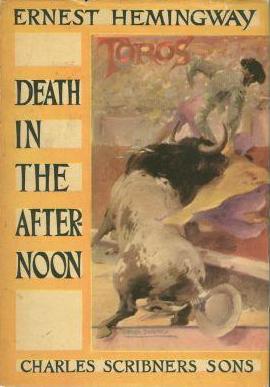In 2012 and 2013 I was researching marketing strategies for a mixed martial arts company. I conducted focus groups and surveys on what people liked about mixed martial arts, what they didn’t like about mixed martial arts, and what messaging was most effective in creating a desire to watch a mixed martial arts fight. I found that the most important factor in an individual enjoying mixed martial arts was their understanding the abilities and skills of the fighters, their execution, and the strategy in fighting their opponent. If a person was able to appreciate those aspects of a fight they would enjoy it, because they could look past the blood, the violence, and any part of the fight that might be offensive to the average person. Instead of seeing only violence, they saw sport in it.
Death in the Afternoon by Ernest Hemingway is a book you should read to develop an appreciation of bullfighting. It is a great descriptor of the pageantry, what makes it beautiful, what makes it ugly, the art present in it, as well as the feelings one gets during and after the event. The book has an enormous amount information on the history, ritual, and art of bullfighting. After reading the book, one could see a bullfight in person and enjoy at least one part of the event. If you are going to go to a bullfight, this is required reading.
There are very few books that match the passion, energy, and love behind a topic as much Death in the Afternoon. From the very first pages you can tell that this person is an expert and cares deeply about bullfighting. At some point, someone’s extreme interest in a topic makes it compelling, no matter what the content is. While this book does not have the emotional triggers and characters that Hemingway’s works of fiction have, you can feel his passion for the sport on every page.
I would not recommend this book as an introduction to Hemingway, but it has its merits as a great example of expository writing and has its place as a book that should be read. After having seen a bullfight myself, I am not as compelled as Hemingway is by them. Rereading this book, I find that the descriptions of the event, the poetry, the art, and the abstract concepts present are significantly more interesting and enlightening than an actual bullfight itself.
The elephant in the room
There is no way to avoid the elephant in the room and it should be addressed before discussing the contents of Death in the Afternoon. As Hemingway notes, bullfighting is an indefensible event that is a ritualistic killing of an animal.
It is also an event that has been occurring for hundreds of years in various parts of the world and carries historical significance to communities. A person could argue that criticism of bullfighting as cruel and barbaric is too narrow and misplaced. After all, animals are treated cruelly in a variety of conditions that most people are not outraged about, such as breeding cattle for food. The criticisms of bullfighting are fair and the comparison to modern cattle breeding says a lot more about cattle breeding than it does bullfighting.
I spoke with a Spaniard from the north about their thoughts on bullfighting. While they thought there was truth to the criticisms, they thought some of the criticism was unfair. The Spaniard had some justifications for bullfighting that were reasonable and well-supported. However, many opponents to bullfighting would likely not be swayed. The Spaniard’s argument that stuck with me was when they said, “Los corridas de toros have been in my region for hundreds of years. It is part of our culture. I don’t care what Catalonia thinks of it. I like it, many people I know like it, and if this event was as evil as many other people in Spain thought it was, it would be illegal, but it’s not.”
Thoughts on the book

Hemingway has a collection of 20 chapters and covers such topics as the history of the sport, common observations of people who see a bullfight for the first time, what makes a matador great, what makes a bull great, what makes for a great fight, and an explanation of the rituals of the bullfight. Following the chapters there is a collection of photos that illustrate some of the things Hemingway talks about such as the outfits, the veronicas, and the various stages of the bullfight.
Hemingway does not advocate for or against bullfighting, and states that he only wants to explain it. In the first chapter he writes:
“I suppose, from a modern moral point of view, that is, a Christian point of view, the whole bullfight is indefensible; there is certainly much cruelty, there is always danger, either sought or unlooked for, and there is always death, and I should not try to defend it now, only to tell honestly the things I have found true about it.”
Due to this lack of intent to justify the sport, I don’t think this book will change anyone’s opinion on bullfighting. If one hates bullfighting, there is nothing to be gained from reading this book unless they had a very strong interest in studying its expository structure. Any other person may learn about what occurs at a bullfight, and while they may not gain an appreciation of bullfighting the way I still do not care for modern art no matter how much I learn about it, there will be a better understanding of the skills that and pageantry associated with it.
Hemingway spends considerable time explaining how a bullfight is different from other form of competition. The concept of a bullfight is different that modern sports. He states that bullfighting is not a competition in the “anglo-saxon” sense of the word. It is not a fight the way the layperson thinks of a fight: two entities competing against each other to win. Bullfighting is a tragedy because the outcome predetermined. The bull must die. In Spanish, the name for the bullfight is the “corrida de toros” or the “running of the bulls” and is meant to imply a struggle more than a fight.
In an event that has a predetermined ending, one has to ask, what’s the point of it all? What is the appeal? Why do people pay money to see this?
According to Hemingway, the appeal is that it is an art. He asserts that “Bullfighting is the only art in which the artist is in danger of death and in which the degree of brilliance in the performance is left to the fighter’s honor.” The brilliance of the performance is the “art” of the turns and passes with the muleta (what we know as the bright cape), the danger the matador puts himself in (because without the presence of danger there is no bravery), and the exactness and ease at which the matador performs. To give support to Hemingway’s contention that bullfighting is an art, the results and descriptions of bullfighting in Spain are not always in the sports section of the newspaper, but instead can be found in the culture section.
Hemingway goes into great detail on the “artistic” aspects of the bullfight. He talks about how matadors study a bull, the passes, and how matadors string together passes in a technically superior and brave way. He writes about the development of a matador’s skills over the course of their lives as well as their mental ability to face death and danger. A point emphasized throughout the book is that matadors act not in spite of these feelings but actually embrace them as a necessary part of achieving the highest level of the art. Specific matadors named, sometimes to an an excessive amount, and their mentality, skills, and reaction to their first goring are described and analyzed.
There are a few clunky parts in this book. For example, Hemingway has a “conversation” with a woman who saw a bullfight and they have a dialogue. While this is innovative and unique, it is awkward. Maybe that’s due to its novelty. During the conversation with the woman, Hemingway includes the story “A Natural History of the Dead” as an aside, which seems very out of place. There are many tangents covering topics on the nature of writing, Hemingway’s writing beliefs, and what makes a good writer. He makes fun of critics and Americans who think they will like bullfighting, spend a lot of money on front-row tickets, and then leave after the first fight. These excerpts slow the pace of the book and if they came up in conversation you were having with another person they would be a tangent that you wish they would hurry through.

At times, the book becomes a meditation on bravery, expertise, life, death, and facing certainty in life with bravery. Some may find these segments over the top and detract from the explanation of bullfighting. I found these passages to be a highlight, turning the art into an almost poetic act and an abstract idea. It’s reasonable to go to a bullfight and find that the symbolism and abstract concepts of the matador and the bullfight are superior to a bullfight itself. I have heard many people go to a bullfight and not see the point and not see the appeal. While bullfighting is an institution in some parts of the world that will never be banned, the matador transcends the corrida de toros as a symbol of much more than a killer of bulls.
Conclusion
Hemingway warns against going into any bullfight with preconceived notions on what you may like or dislike. I know this to be true firsthand. I think a person should also go into reading this book without holding onto any preconceived beliefs about what they will read or what they will like. A reader can come to appreciate bullfighting the same way someone may appreciate art without having an emotional attachment to the art and simultaneously thinking that all modern art is valueless and void of talent. By the end of chapter 3 you will have an idea of whether to keep reading or whether you want to drop the book. At the very least, it is a great expository work that could be read by any non-fiction writer as an example with merit to adopt. At best, it could be considered an exploration of the human experience.
Rating: 8/10
Rating Criteria
The rating system is 0-10. A 1 is a book I barely finished and a 0 is a book that I disliked so much that I did not finish. A 2-3 is a book I really did not like and two standard deviations below the median. A 5 is dead-center average. A 4-6 sill is still in the “average” range because they are within one standard deviation of average. A 7-8 is very good and two standard deviations away and are equally as good as a 2 or 3 is bad. A 9 is exceptionally good. A 10 is one of the best books I have read.
Some books are on a curve. A book that is not advertised or held as the finest works of literature is graded differently than a genre romance novel or pulp spy novel. For example, a perfect comedy book can get the same ranking as The Great Gatsby.

